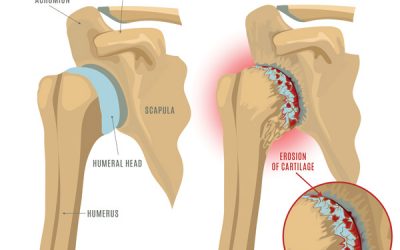The alignment of the neck and the entire shoulder complex are key structures involved and responsible for maintaining the health and resilient of the soft tissue support. Most shoulder muscles have their origin attachment in the scapulothoracic region and inserted point on the shoulder. Their corresponding tendons are used as powerful leverages to aid on the required movement. Therefore, when the spine and shoulder complex are misaligned, this lack of mobility of the joint, makes the muscle support system having to compensate and contract harder in attempt to maintain the overall movement which eventually overload the muscle support system leading to the appearances of muscle and tendon injuries.
Shoulder tendinopathies can be extremely painful as per the concentration of nerve receptors accumulated on the tendon. Generally, patients report a localised sharp pain in the tendon involved, causing everyday tasks such carrying and lifting the arm quite difficult.
Key shoulder misalignments and the associated tendon/bursa and muscle injury
Anterior – Inferior (AI) shoulder is commonly associated with Supraspinatus tendinitis, tendinosis, tear, Subacromial Impingement syndrome and Subacromial bursitis.

Impingement-syndrome
Externally Rotated (AEX) shoulder is associated with Long head of biceps tendinitis, tendinosis and lateral tendon misplacement.

Long-head-biceps-tendinitis
Fixed Scapula misalignment is associated with, Infraspinatus, Teres minor and Subscapular tendinitis/tendinosis

Subscapular-tendinitis
Mechanism of injury
Once the shoulder dysfunction is installed; the location of the injury will be dependent on the mechanism of the trauma. For instance, activities that involves flexion and extension movements predisposed to a location of injury different from the abduction and adduction movements.
Assessment
Clinical evaluation of the shoulder alignment and specific orthopaedic tests to pinpoint the location of the injured muscle/tendon
X-ray
Anterior – posterior (AP) shoulder view is an essential imaging to check the different patterns of shoulder misalignments.
MRI
Locate the exact injury point; Allows the treatment to be more specific during the application of the treatment modalities, in addition aids to identify the type of tendinopathy (tendinitis or tendinosis) and the corresponding appropriate treatment care.
Identify the extent of tissue damage and the presence of scar tissue; Provides valuable information regarding prognosis and the application of friction soft tissue modalities to aid on scar tissue removal.
Treatment Protocol
Specific Spinal and Shoulder adjustments followed by a rehabilitation regime to strengthen the entire soft tissue support.
Application of Low-level Laser and PEMF to aid on the cellular level of heling as well as improving the microcirculation for the area.
Friction soft tissue therapy helps to reduce dysfunctional scar tissue
Dry needling may be used to improve local blood flow and to reduce the deep muscle tension.
Specific selected essential oil application to enhance healing
Depending on level of misalignment and chronicity a minimum of 6 weeks up to 12 weeks of treatment care may be necessary to resolve this deformity.




